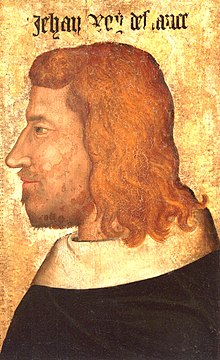
Back Chuan II de Francia AN جان الثاني ملك فرنسا Arabic جان التانى ملك فرنسا ARZ Jean II (gazik ke Franca) AVK II İoann (Fransa kralı) Azerbaijani ایکینجی ژان (فرانسه) AZB Іаан II Добры Byelorussian Жан II Bulgarian Yann II (Bro-C'hall) Breton Ivan II, kralj Francuske BS
| John II | |
|---|---|
 Portrait on wood panel around 1350, Louvre Museum | |
| King of France | |
| Reign | 22 August 1350 – 8 April 1364 |
| Coronation | 26 September 1350 |
| Predecessor | Philip VI |
| Successor | Charles V |
| Regent | Charles, Dauphin of France (1356–1360) |
| Born | 26 April 1319 Le Mans, France |
| Died | 8 April 1364 (aged 44) Savoy Palace, London, England |
| Burial | 7 May 1364 |
| Spouses | |
| Issue | |
| House | Valois |
| Father | Philip VI of France |
| Mother | Joan of Burgundy |
| Signature |  |
John II (French: Jean II; 26 April 1319 – 8 April 1364), called John the Good (French: Jean le Bon), was King of France from 1350 until his death in 1364. When he came to power, France faced several disasters: the Black Death, which killed between a third and a half of its population; popular revolts known as Jacqueries; free companies (Grandes Compagnies) of routiers who plundered the country; and English aggression that resulted in catastrophic military losses, including the Battle of Poitiers of 1356, in which John was captured.
While John was a prisoner in London, his son Charles became regent and faced several rebellions, which he overcame. To liberate his father, he concluded the Treaty of Brétigny (1360), by which France lost many territories and paid an enormous ransom. In an exchange of hostages, which included his son Louis I, Duke of Anjou, John was released from captivity to raise funds for his ransom. Upon his return to France, he created the franc to stabilize the currency and tried to get rid of the free companies by sending them to a crusade, but Pope Innocent VI died shortly before their meeting in Avignon. When John was informed that Louis had escaped from captivity, he voluntarily returned to England, where he died in 1364. He was succeeded by his eldest son, Charles V.